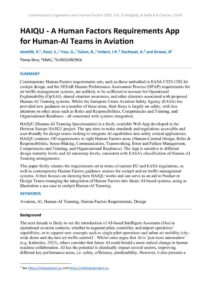| Document | Author Venditti, R.1, Pozzi, S.,1 Frau, G.,1 Salam, R.,1 Imbert, J-P.,2 Duchevet, A.2 and Kirwan, B3 |
| Abstract Contemporary Human Factors requirements sets, such as those embodied in EASA CS29.1302 for cockpit design, and the SESAR Human Performance Assessment Process (HPAP) requirements for air traffic management systems, are unlikely to be sufficient to account for Operational Explainability (OpXAI), shared situation awareness, and other elements associated with proposed Human-AI Teaming systems. Whilst the European Union Aviation Safety Agency (EASA) has provided new guidance on a number of these areas, their focus is largely on safety, with less attention on other areas such as Roles and Responsibilities, Competencies and Training, and Organisational Readiness - all concerned with systems integration. HAIQU (Human-AI Teaming Questionnaire) is a freely available Web App developed in the Horizon Europe HAIKU project. The app aims to make standards and regulations accessible and user-friendly for design teams looking to integrate AI capabilities into safety critical applications. HAIQU contains 180 requirements in eight Human Factors areas (Human-Centred Design, Roles & Responsibilities, Sense-Making, Communication, Teamworking, Error and Failure Management, Competencies and Training, and Organisational Readiness). The App is sensitive to different design maturity levels and AI autonomy levels, consistent with EASA's classification of Human-AI Teaming arrangements. This paper firstly situates the requirements set in terms of current EU and EASA regulations, as well as contemporary Human Factors guidance sources for cockpit and air traffic management systems. It then focuses on showing how HAIQU works and can serve as an aid to Product or Design Teams managing the integration of Human Factors into future AI-based systems, using as illustration a use case in cockpit Human-AI Teaming. |

